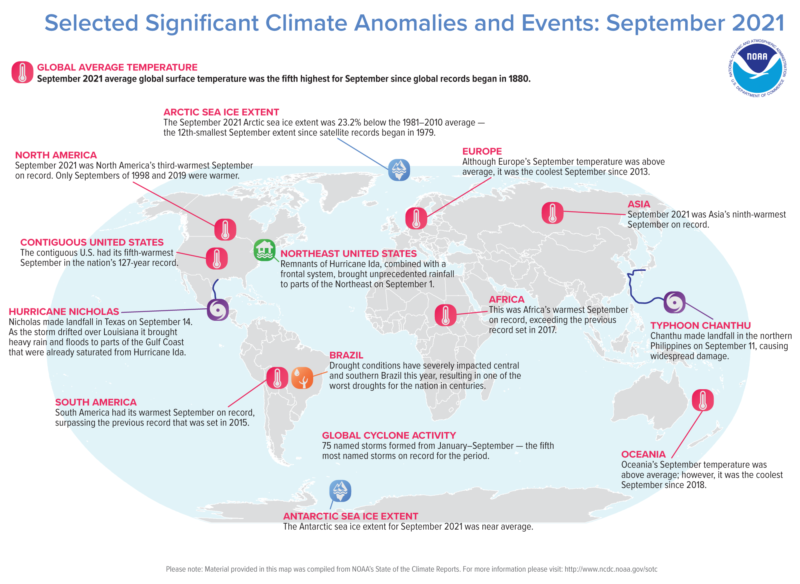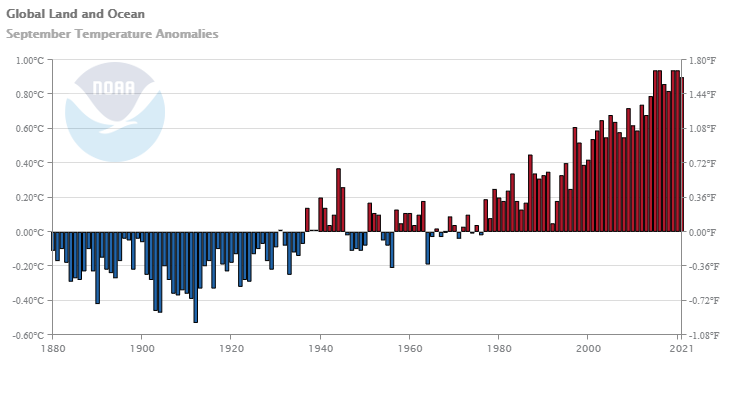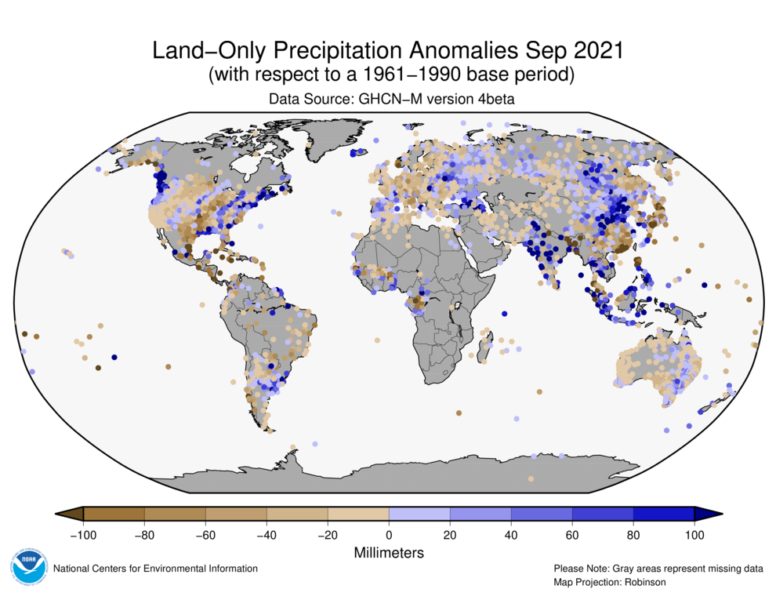
Temperature
The global surface temperature for September 2021 was 0.90°C (1.62°F) above the 20th century average of 15.0°C (59.0°F) and was the fifth-highest September temperature in the 142-year record. Only Septembers of 2015, 2016, 2019, and 2020 had a higher September temperature departure. The eight warmest Septembers have all occurred since 2014. September 2021 also marked the 45th consecutive September and the 441st consecutive month with temperatures, at least nominally, above the 20th-century average.

The Southern Hemisphere’s September 2021 surface temperature departure of +0.70°C (+1.26°F) was the warmest September in the 142-year record, surpassing the previous record set in 2018 by 0.02°C (0.04°F). This was mainly driven by the very warm Southern Hemisphere land, which had its second warmest September on record. Only September 2020 was warmer. Meanwhile, the Northern Hemisphere had its fifth-warmest September on record at +1.09°C (+1.96°F).
North America’s September 2021 temperature departure of +1.58°C (2.84°F) was the third-highest for North America on record, behind Septembers of 1998 and 2019. The contiguous U.S. had its fifth warmest September on record.
Precipitation
Significantly below-average precipitation occurred across from the southwestern contiguous U.S. to parts of the northern Great Plains, as well as parts of Texas to parts of the Midwest. Southeastern Brazil, southern Chile and southern Argentina, parts of central and northern Europe, southern Australia, and parts of Asia were also drier than normal. Significantly above-average precipitation occurred in the northwestern and northeastern contiguous U.S., northern Argentina, Spain, western, southern and eastern parts of Asia, and southeastern Australia.
According to reports, parts of central Africa have been affected by heavy rain since the beginning of their rainy season in July. In Chad, about 250,000 people have been affected, while over 700,000 people have been affected in Sudan and South Sudan so far. The heavy rain triggered floods that damaged infrastructures, affected farming as crops were either damaged or destroyed, and was also responsible for the loss of livestock.

Drought conditions have severely impacted central and southern Brazil this year, resulting in one of the worst droughts for the nation in centuries. According to reports, the lack of rain has resulted in water scarcity, increased fire activity, and crop losses. The rainfall deficit also impacted the energy sector since hydroelectric reservoirs are low or empty, prompting the Brazilian government to encourage its residents to consume less energy. On September 27, strong winds caused a dust storm over San Pablo, reducing visibility drastically.
Over North America the very general pattern of negative anomalies in the western portion and positive anomalies in the east continues in September. The drier than normal zone in the west is an extension of the larger feature in the anomaly maps across most of the subtropical Pacific, with a more intense than normal mid-latitude precipitation feature extending from Asia into the North America coastal areas. The North American monsoon weakened in September and did not provide relief this month in the southwest U.S. The Gulf of Mexico had some tropical cyclone activity that affected parts of Texas, Louisiana and even flooding in New York City at the beginning of the month.
Read the full report here: https://www.ncdc.noaa.gov/sotc/global/202107

